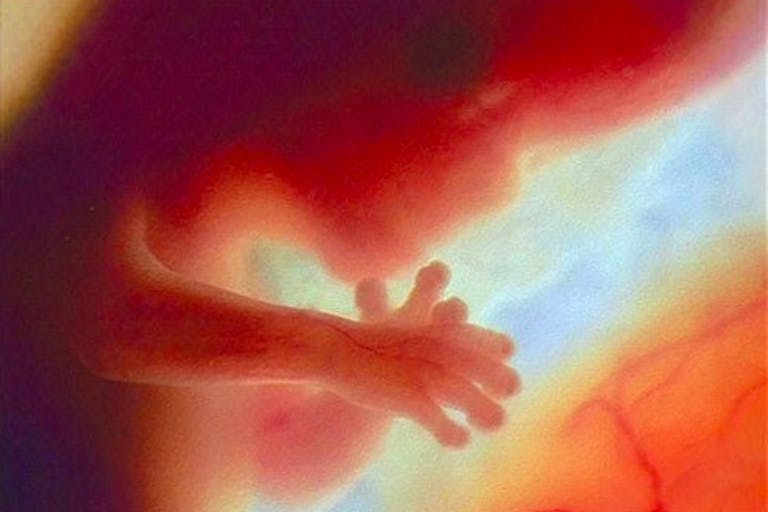
Abortion activist secures removal of pro-life billboards in British Columbia
Bridget Sielicki
·
Researcher calls for pro-abortion ACOG to update its claims on fetal pain
A researcher is calling on the pro-abortion American College of Obstetricians and Gynecologists (ACOG) to update its information concerning fetal pain to bring it in line with current research. New research has found that preborn children feel pain months earlier than those in the abortion industry admit. However, regardless of whether or not a human being can feel pain, deliberately ending the lives of human beings is wrong.
A biased organization
ACOG isn’t shy about its stance in favor of abortion, using its position as a trusted OB/GYN group to advance the agenda of the abortion industry. Members include well-known and vocal abortionists Daniel Grossman and Jen Gunter — who once referred to preborn babies as “zombies.” The American Association of Pro-Life Obstetricians and Gynecologists (AAPLOG) has stated that ACOG “does not adequately represent its thousands of members” and that “a narrow pro-abortion leadership majority” has “seized control of ACOG.”
This tweet is no longer available. It may have been deleted or made private. Try on X.
In order to push abortion as normal health care, ACOG appears to be relying on outdated research to claim that preborn children are incapable of feeling pain until “at least 24 weeks” (6 months). The problem with this, according to John Bockmann, is that new research has proven that preborn children can feel pain by 12 weeks (3 months), and he didn’t hold back on Twitter when he told ACOG to update its fact sheet to reflect this.
“Can a fetus feel something like pain before viability, perhaps even by 15 weeks’ gestation?” wrote Bockmann. “The American College of Obstetricians and Gynecologists (@acog) has long said no, but increasing evidence suggests that the answer is yes. I’d like them to reconsider their stance.”
Outdated research
Using ACOG’s “Facts are Important: Fetal Pain” information sheet from its website, Bockmann made recommendations on how the fact sheet should be updated. He tagged Grossman and Gunter as well as abortionist Leah Torres, who once claimed God commits more abortions than she does. Bockmann states that ACOG cites outdated information regarding the necessity of a functioning cortex in order to feel pain.
“ACOG cites two studies: The Royal College of Obstetricians and Gynaecologists’ 2010 report on fetal awareness (RCOG 2010), which Dr. [Stuart] Derbyshire co-wrote, and Lee and colleagues’ 2005 review on fetal pain published in the Journal of the American Medical Association (JAMA 2005),” said Bockmann. “Though presented together, these studies disagree with each other and fail to substantiate their underlying assumption of cortical necessity.”
READ: How two researchers from opposite sides of the abortion debate teamed up to study fetal pain
The JAMA study found that fetal pain occurs around 29 to 30 weeks when neurons in the cortex begin to function, but the RCOG research said fetal pain begins no earlier than 24 weeks based on when those same neurons demonstrate function. Because the studies “disagree and are moot,” he explained, “ACOG’s ‘Facts are Important’ is moot.”
New research negates ACOG’s claims
Bockmann pointed to recent studies from 2012 and 2016 which found that the cortex does not need to be functioning in order for a human being to feel pain. “Even if the cortex is somehow necessary for pain perception, a sort of proto-cortex called the subplate seems to afford cortex-like sensory functions while the cortex is still forming,” explained Bockmann. “Subplate connections to peripheral nerves begin to form ~12 weeks.”
When looking specifically at the research from RCOG regarding these subplate connections, which ACOG uses to support its claim that preborn children can’t feel pain, Bockmann points out that RCOG’s reasoning is not sound. “What is RCOG 2010’s opinion on subcortical structures? They cannot produce ‘mature function,’ it says — a term which it leaves undefined, but which apparently rules out any possibility of fetal pain,” he said.
This tweet is no longer available. It may have been deleted or made private. Try on X.
“Likewise, ‘Interpretation of existing data indicates that cortical processing of pain perception, and therefore the ability of the fetus to feel pain, cannot occur before 24 weeks of gestation.’ As the late Martin Ward Platt observed in his 2011 critique, ‘We could rewrite this as “in theory they can’t feel pain, therefore they don’t.”‘”
Bockmann continued, “Worse, in RCOG 2010’s opening summary, the authors wrote, ‘As most neuroscientists believe that the cortex is necessary for pain perception, it can be concluded that the fetus cannot experience pain in any sense prior to this gestation.’ Or as I would say, ‘They conclude that their conclusion can be concluded.'”
Article continues below
Dear Reader,
In 2026, Live Action is heading straight where the battle is fiercest: college campuses.
We have a bold initiative to establish 100 Live Action campus chapters within the next year, and your partnership will make it a success!
Your support today will help train and equip young leaders, bring Live Action’s educational content into academic environments, host on-campus events and debates, and empower students to challenge the pro-abortion status quo with truth and compassion.
Invest in pro-life grassroots outreach and cultural formation with your DOUBLED year-end gift!
Why does fetal pain capability matter?
Though the abortion industry claims abortion is health care, abortion is actually a brutal act perpetrated against a vulnerable human being — especially the most commonly used second-trimester procedure known as D&E abortion. In this type of abortion, the preborn child is usually alive when the abortionist tears her limbs from her torso — and, as research now shows, the child can likely feel that pain. Most Americans want abortion to be restricted to the first trimester, prior to the timeframe in which D&E abortion is used.

However, regardless of whether or not a preborn child can feel pain, abortion is a violent and inhumane act that exists solely to kill innocent human beings who are considered unwanted or undesirable.
ACOG must acknowledge new research findings
Bockmann makes clear that ACOG’s references are out-of-date and invalid, including older research from his pro-abortion co-researcher Dr. Stuart Derbyshire, who has in recent years changed his stance on fetal pain and joined Bockmann in authoring Reconsidering Fetal Pain. Both Bockmann and Derbyshire found “compelling evidence” that contradicts ACOG’s claims. In order to “communicate the evidence more accurately and preserve public trust,” Bockmann requests “that ACOG promptly make” some revisions, including changing the age of when a preborn child can feel pain from ACOG’s “after viability” to the accurate and research-based “12 weeks’ gestation.”
Bockmann also wants ACOG to add to its fact sheet research that includes the fact that “[p]ain in human fetuses […] need not be equivalent to adult human pain in order to matter morally. Both respond in every way as though they feel pain. Anesthesia, normally given to animals and human fetuses during surgery, calms these responses.” He also called on the organization to remove its statement claiming that “evidence shows that the neural circuitry necessary to distinguish touch from painful touch does not, in fact, develop until late in the third trimester,” because it is inaccurate.
“[A]s a trusted medical authority, ACOG should update its ‘Facts are Important’ statement to acknowledge the possibility of fetal pain at 12 weeks’ gestation. Meanwhile, clinical procedures and public policy should reflect these findings,” said Bockmann.
If ACOG wishes to be a trusted resource for doctors and women, it must not use outdated research to back up its own pro-abortion beliefs. In doing so, it exposes itself as a biased group that will ignore new scientific findings to fit its own agenda. The truth is that preborn children can feel pain much earlier in development than previously believed, and some research indicates they may actually feel it to a greater extent than adults do.
ACOG, as a source that women trust, must be honest about what current research says about life in the womb so that women know the truth before undergoing an abortion.
Read Bockmann’s entire Twitter thread here.
Editor’s Note: This article has been corrected since its original publication.
“Like” Live Action News on Facebook for more pro-life news and commentary!
Live Action News is pro-life news and commentary from a pro-life perspective.
Contact editor@liveaction.org for questions, corrections, or if you are seeking permission to reprint any Live Action News content.
Guest Articles: To submit a guest article to Live Action News, email editor@liveaction.org with an attached Word document of 800-1000 words. Please also attach any photos relevant to your submission if applicable. If your submission is accepted for publication, you will be notified within three weeks. Guest articles are not compensated (see our Open License Agreement). Thank you for your interest in Live Action News!

Bridget Sielicki
·
Issues
Angeline Tan
·
Issues
Bridget Sielicki
·
Issues
Nancy Flanders
·
Politics
Bridget Sielicki
·
Issues
Sheena Rodriguez
·
Issues
Nancy Flanders
·
Human Interest
Nancy Flanders
·
Investigative
Nancy Flanders
·
Pop Culture
Nancy Flanders
·
Human Interest
Nancy Flanders
·